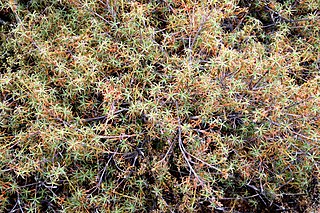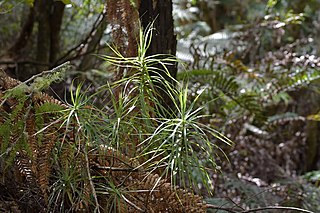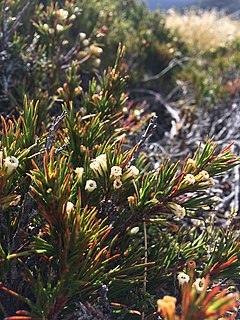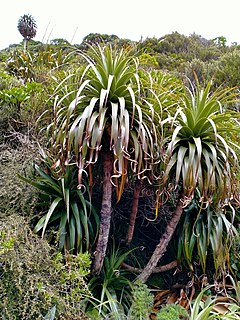
Dracophyllum is a genus of plants belonging to the family Ericaceae, formerly Epacridaceae. There are 61 species in the genus, mostly shrubs, but also cushion plants and trees, found in New Zealand, Australia, Lord Howe Island and New Caledonia. The name Dracophyllum, meaning dragon-leaf, refers to their strong similarity to the unrelated Dracaena, sometimes known as dragon tree. Although dicotyledonous, they resemble primitive monocots with their slender leaves concentrated in clumps at the ends of the branches; they are sometimes called grass-trees.

Dracophyllum recurvum, known commonly as curved leaf grass tree or neinei is a prostrate to semi-erect shrub belonging to the genus Dracophyllum.

Dracophyllum milliganii is a species of angiosperm in the family Ericaceae and the sub-family Epacridoideae. It is a distinctive alpine shrub, endemic to Western Tasmania.

Dracophyllum longifolium, commonly called inaka, is an upright shrub or small tree in the family Ericaceae that is endemic to New Zealand.

Dracophyllum arboreum, commonly known as Chatham Island grass tree and tarahinau (Moriori), is a species of tree in the heath family Ericaceae. Endemic to the Chatham Islands of New Zealand, it reaches a height of 18 m (60 ft) and has leaves that differ between the juvenile and adult forms.

Dracophyllum traversii, commonly known as mountain neinei, grass tree, and pineapple tree is a deciduous tree endemic to New Zealand. In the heath family Ericaceae, it reaches a height of 0.2–13 m (0.66–42.65 ft) and has leaves which form tufts at the end of its branches; it has a lifespan between 500 and 600 years.

Dracophyllum elegantissimum, commonly known as grass tree or slender dragon tree, is a flowering plant in the family Ericaceae. Endemic to New Zealand, it is found in the north of the South Island, in north-west Nelson.

Dracophyllum townsonii is a species of shrub or small tree endemic to the north of New Zealand's South Island. It was first described by Thomas Cheeseman in 1906 and gets the specific epithet townsonii after the chemist and plant collector William Townson. In the heath family Ericaceae, it inhabits mountain slopes and reaches a height of 3–6 m.

Dracophyllum scoparium is a species of shrub or small tree endemic to the Chatham Islands of New Zealand. It was first described by Joseph Dalton Hooker in 1844 and gets the specific epithet scoparium, in the form of a broom, for the way in which its juvenile leaves grow. In the heath family Ericaceae, it inhabits the Chatham and Pitt Islands, and reaches a height of 1–4 m.

Dracophyllum strictum, commonly known as totorowhiti, is a species of shrub endemic to New Zealand. It was first described by Joseph Dalton Hooker in 1844 and gets the specific epithet strictum for its rigid and packed together leaves. In the heath family Ericaceae, it inhabits lowland up to montane forest and shrubland and reaches a height of 50–300 cm.

Dracophyllum patens, commonly called Great Barrier Inaka, is a species of plant in the family Ericaceae that is endemic to New Zealand.

Dracophyllum sinclairii, commonly called gumland grass tree, is a species of plant in the family Ericaceae that is endemic to New Zealand.

Dracophyllum menziesii, commonly known as pineapple scrub, is a species of shrub endemic to the South and Stewart Islands of New Zealand. It was first described by Joseph Dalton Hooker in 1853 and gets the specific epithet menziesii after the Scottish surgeon and naturalist Archibald Menzies. In the heath family Ericaceae, it inhabits mountain slopes and cliffs from sea level up to 1,500 m (4,921 ft) and reaches a height of 0.5–1 m (1.6–3.3 ft). A 2017 assessment using the New Zealand Threat Classification System classified it as "Not Threatened," giving it an estimated population upwards of 100,000.

Dracophyllum rosmarinifolium, commonly known as inaka and common grass tree, is a species of shrub endemic to the North and South Islands of New Zealand. It was first described by Georg Forster in 1786 as Eparcris rosmarinifolium and gets the specific epithet rosmarinifolium for its similarities to species from the former genus Rosmarinus. In the heath family Ericaceae, it inhabits subalpine and montane gullies, cliffs, plateaux, valley floors and ridges, and reaches a height of 0.3–1 m (1.0–3.3 ft). A 2017 assessment using the New Zealand Threat Classification System classified it as "Not Threatened," giving it an estimated population of over 100,000.

Dracophyllum fiordense, commonly known as Fiordland grass tree, is a species of tree or shrub endemic to the South Island of New Zealand. In the heath family Ericaceae, it reaches a height of 1.5–5.0 m (5–16 ft), and has leaves which form tufts at the end of its branches. It has long, thin, green leaves with a distinctive curled spiral at their tips, and a pyramid-shaped inflorescence that is hidden under the clump of leaves. It has tiny pink flowers, between 113 and 120 on each spike, and equally tiny reddish-brown dry fruit. D. fiordense inhabits forests, both lowland and subalpine, shrubland, and even tussock grassland, on mountain slopes, gullies and ridges. Its range occurs in two main groups, one in Fiordland National Park, and one in the Mount Cook and Westland National Parks.

Dracophyllum trimorphum, commonly known as inaka and dracophyllum, is a species of shrub or small tree endemic to north-west Nelson in New Zealand's South Island. It was first described by Walter Oliver in 1952 and gets the specific epithet trimorphum for its three phases of growth. In the heath family Ericaceae, it inhabits cliffs and steep slopes near the coast and reaches a height of 0.2–3.0 m (1–10 ft). A 2017 assessment using the New Zealand Threat Classification System classified it as “Naturally Uncommon,” giving it an estimated habitat area of less than 10 km2 (1,000.0 ha).

Dracophyllum kirkii is a species of shrub endemic to the South Island of New Zealand. It was first described by Sven Berggren in 1877 and gets the specific epithet kirkii after the New Zealand botanist Thomas Kirk. In the heath family Ericaceae, it inhabits mountain slopes and bluffs and reaches a height of just 20–140 cm (8–55 in). A 2017 assessment using the New Zealand Threat Classification System classified it as “Not Threatened,” giving it an estimated population of more than 100,000.

Dracophyllum filifolium is a species of shrub or tree endemic to the North, South, and Stewart Islands of New Zealand. It was first described by Joseph Dalton Hooker in 1853 and gets the specific epithet filifolium for its leaves being like a filament. In the heath family Ericaceae, it inhabits mountain slopes, saddles and ridges and reaches a height of 1–4 m (3–13 ft). A 2017 assessment using the New Zealand Threat Classification System classified it as “Not Threatened,” giving it an estimated population of more than 100,000.

Dracophyllum acerosum is a species of shrub or small tree endemic to New Zealand's South Island. It was first described by Sven Berggren in 1877 and gets the specific epithet acerosum, meaning needles shaped, for its leaves. In the heath family Ericaceae, it inhabits mountain slopes, ridge lines and hillsides and reaches a height of 1–2 m (3–7 ft). A 2017 assessment using the New Zealand Threat Classification System classified it as “Not Threatened,” giving it an estimated population of more than 100,000.


















